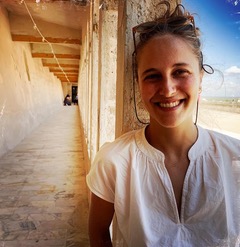Entering PIETRO – a new exhibition space that opened its doors on May 11 in Bologna – one immediately gets the impression of venturing into a place characterized by a certain intimacy. PIETRO was born in via Galliera 20, where the seventeenth-century Palazzo Tanari stands: precisely on the ground floor, occupying the space of a hall frescoed at the end from the eighteenth century, connected to a small private chapel. Simone Gheduzzi – architect and creator of this new hotbed for ideas in the heart of the historic center of Bologna – wanted to inaugurate this special opening with the sculptures by Marcello Tedesco, already known in the city for the mtn | museo temporaneo navile project.

Marcello Tedesco, Expedients Exhibition, ph. Luca Bolognese, courtesy PIETRO
Once you cross the entrance threshold, leaving the urban noise behind you, you immediately enter another space, overshadowed by a soft and liturgical light; walking down a narrow corridor, one cannot help but notice a small group of objects – mostly books and notebooks – belonging to Gheduzzi. It is a significant hint of the poetics of confrontation and dialogue to which PIETRO aspires, emanated by the spirit of sharing which this exhibition of personal documents, arranged on some shelves domestic in appearance, aspires to.

Marcello Tedesco, Modello architettonico, 2019, patinated and burnt plaster, raw earth, steel, terracotta, compacted earth, high density polystyrene, ph Luca Bolognese, courtesy PIETRO
By accessing the frescoed hall, one immediately deals with the main theme of the Expedients Exhibition: the connection between architecture and sculpture. In the middle of the hall, supported by a slender scaffolding of steel pipes, lies Modello architettonico (2019) made of patinated and burnt plaster, raw earth and high-density polystyrene. This sculpture evokes a non-place located elsewhere, which we could identify with the artist’s unconscious. The visitors can turn into an ant for a few seconds and imagine themself walking along the serpentine corridor, reaching a pentagonal structure that has every appearance of resembling a sacred temple. If an ascension is magically suggested by the Italian garden in trompe l’oeil frescoed on the hall’s vault, within the sculpture the contact with the sacred implores a centripetal, nucleic and nodal vision.

Marcello Tedesco, Espedienti dell’architetto, 2020, mixed technique on paper, ph Luca Bolognese, courtesy PIETRO
The ladders made of raw earth lead into the maze of the creative and dreamlike process and, at the bottom of the last step, the human soul confronted itself with its own vision of the world. Humanity does not appear here, but we deduce its presence thanks to the invisible thread that these works establish between each other: this reference conducts us to the drawing standing in front of the sculpture. The visitor needs to kneel down and to descend to carefully observe Espedienti dell’architetto – a drawing located just above the floor level: here, a sort of Hephaestus in half-light contemplates a hollow column in which a burning fire flows and comes out as smoke. Not as much a celebration of the work as of the sacredness of the creative and transformative process: the little flame that feeds the operative process – here the artist’s one, but also the mankind’s one. The invitation to share becomes even more explicit inside the ancient private chapel, where two other works are arranged: Sigillo per orientarsi nello spazio (2021) evokes the labyrinthine sinuosities of that tortuous access path to the sacred space. The other one depicts Progetto per un modello architettonico (2020), where the cylindrical sculpture mentions the one Tedesco had already created in 2019 for mtn | museo temporaneo navile project.

Marcello Tedesco, Deposito, 2020, patinated and burnt plaster, agglomerate of salinized cement, iron rod, ph Luca Bolognese, courtesy PIETRO
The chapel area is intimate and silent. In the background there is the altar, on which the architect-sculptor’s relics are placed: drawings of a project for a confessional, notes, reflections on the weakening of pure geometric forms (remove to create), thoughts on the relationship between spiritual space and earthly space. This material presence, which allows the visitor an introspection – almost never granted to him – in the caves of the artistic laboratory, is the acme of the exhibition: it also consecrates the germinating idea of this new space. In the third and final room, adjacent to the chapel, we find the fifth work on display: Deposito (2020) extends along the entire length of this characteristic room which perhaps alludes to a furnace. It is sort of giant femur, a fundamental structural component that Tedesco cut transversely, as if to show the ravines. What can be pictured is as well the shape of a long drinking trough: the inorganic source becomes visible, the crystalline substrate that underlies the stone creation.

Marcello Tedesco, Expedients Exhibition, ph. Luca Bolognese, courtesy PIETRO
Marcello Tedesco’s works are therefore an expedient to take us elsewhere, within a space where we can observe the invisible of things, what does not appear on the surface, but which exists and forges us by incessantly operating in the upside down of our universe. Finally, this comeback to the original brings us back to the idea of PIETRO’s space, the namesake of the famous keeper of the access keys from the earthly world to the celestial universe.
Daria Ortolani
Info:
Marcello Tedesco, Expedients Exhibition
11/05/2023 – 29/06/2023
PIETRO
Via Galliera, 20 Bologna
www.museotemporaneonavile.org

Graduated in medieval art history at the Bologna Alma Mater Studiorum, she collaborates with the magazine by writing about contemporary art, with a careful eye on sculpture and photography.






NO COMMENT